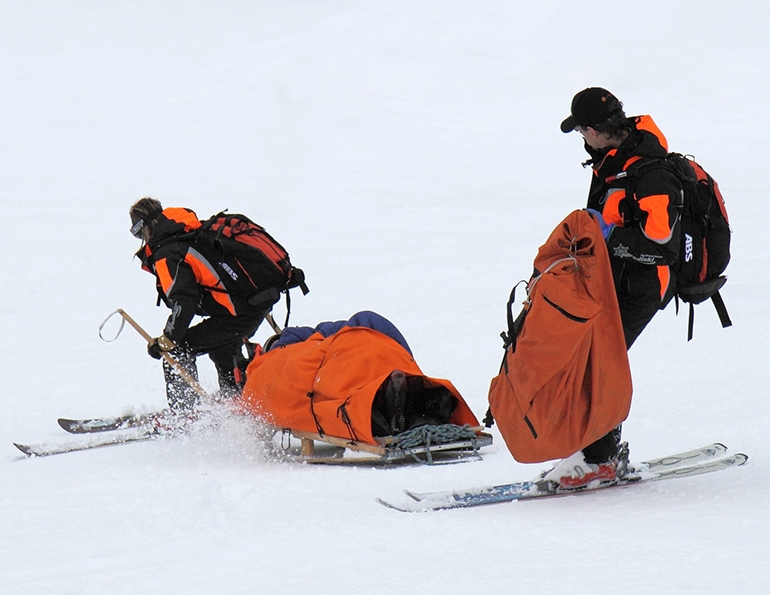It all began with a research study during the 2010-11 winter season. The aim: to gather information on why ski patrollers, lift operators, and snowsport instructors were injured so frequently. The study led to the development of Fit for Snow, a training program that encourages employees to adopt health and performance behaviors—improved diet, hydration, agility, and movement patterns—that reduce workplace injuries and the costs associated with them.
Today, more than 25 North American winter sports operators have used Fit for Snow. All are benefiting from healthier staff and lower injury-liability costs. This is noteworthy, as overall injury rates and related costs in British Columbia, where the study began, and across North America (Figures 1a and 1b) can be significant.
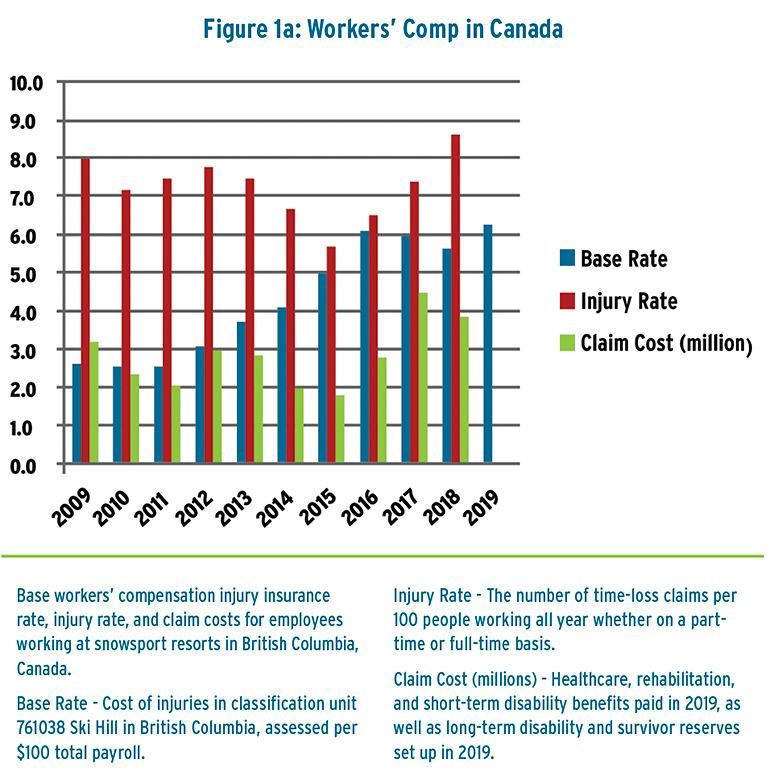
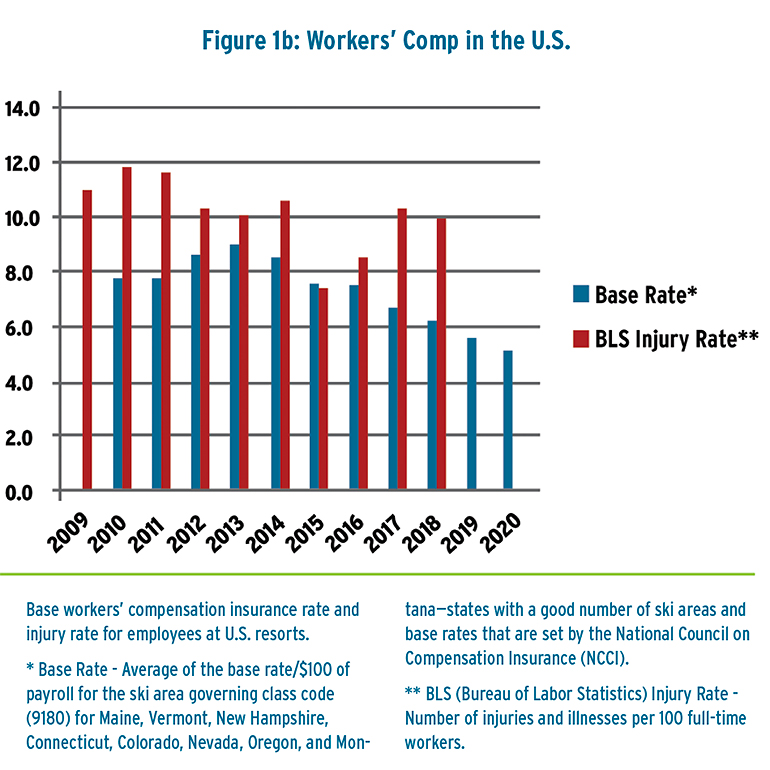
Fit for Snow, combined with having a health and safety committee and following regulations for safety gear, has been proven remarkably effective for keeping employee injuries in check.
How It All Began
The initial study during the 2010-11 winter season collected data on 75 patrollers, lift operators, and snowsport instructors at five resorts in Western Canada. They were monitored to evaluate physical workload, movement strategies, biochemical status, hydration levels, and diet. In addition, blood glucose, reaction time, and decision-making (speed and accuracy) were recorded every two hours over the course of two work days at each resort.
Injury records included time of day and nutritional status at the time of the injury, and were compared to five years of historical data, as well as to a control group of four matched resorts with similar skier visits, terrain, and conditions during the same season.
The program: diet, hydration, agility, fitness. The study findings were used to create discipline-specific training programs, with four main areas of focus: stabilizing blood sugar (diet), maintaining adequate hydration, regular use of joint proprioceptive pattern resetting (exercises to improve agility and movement patterns), and general fatigue mitigation. Step-by-step practical strategies were provided within the context of the existing resort cultures and directed toward achieving personal goals.
The program was delivered to a subset of employees at the five test resorts during 2011-12 pre-season training, along with on-snow workshops mid-season, and injuries were monitored and compared with both historical data and the four control resorts.
The results: Injury rates for the season were 65 percent lower than the five-year historical average. By comparison, the four control resorts experienced an average increase in injury rate of 33 percent over the same season. The study showed that by addressing some of the specific challenges faced by ski resort employees, health and wellness could be integrated effectively with injury prevention, and delivered in a culturally appropriate manner.
Now, 10 years after its inception, the program has evolved and grown, thanks to ongoing data collection and broader implementation at resorts.
Mind Your Blood Sugar!
Diet and blood sugar levels play a large role in wellness. An analysis of three years of data at six resorts in Colorado, New Mexico, and Vermont indicated that 70 percent of both employee and guest injuries were associated with fluctuating blood sugar levels, and that reducing these fluctuations through dietary modification had a significant impact in reducing injuries. Research with other industries has revealed a similar relationship between fluctuating blood sugar levels and impaired reaction time and decision-making.
Thus, as we continue to monitor and refine Fit for Snow, we are better able to understand the key elements necessary for successful implementation of the program.
Program Strengths
Fit for Snow has several attributes that support implementation at any resort operation, including:
• Relevance: Fit for Snow is based on data from winter resorts. That provides a clear focus for its wellness strategies. It’s endorsed by several industry groups based on their experience with the program: the Association of Canadian Mountain Guides, the Canadian Ski Patrol, and the Professional Ski Instructors of America. Plus, the founder (Dr. Roberts) and facilitators are accomplished snowsports athletes themselves.
• Quality: The program is evidence-based within the peer groups of the targeted audience, and it is reviewed and updated regularly.
• Cultural specificity: The format and tools are designed for occupational snowsports athletes.
Case Study: Sugarbush, Vt.
The program’s success at Sugarbush Resort, Vt., demonstrates its effectiveness. Sugarbush employs roughly 150-200 year-round staff, swelling to upwards of 1,000 seasonal staff at peak winter operation. The resort’s intimate yet decentralized management style allows opportunities for non-traditional programming. Plus, recently retired resort president Win Smith had a personal commitment to health and safety—he regularly nabbed 100 ski days per season. All that has created an environment in which Fit for Snow can grow and develop.
In just three years of using Fit for Snow, Sugarbush reduced its staff total and medical injuries by 50 percent, with zero lost time claims in the third season (Figure 2).
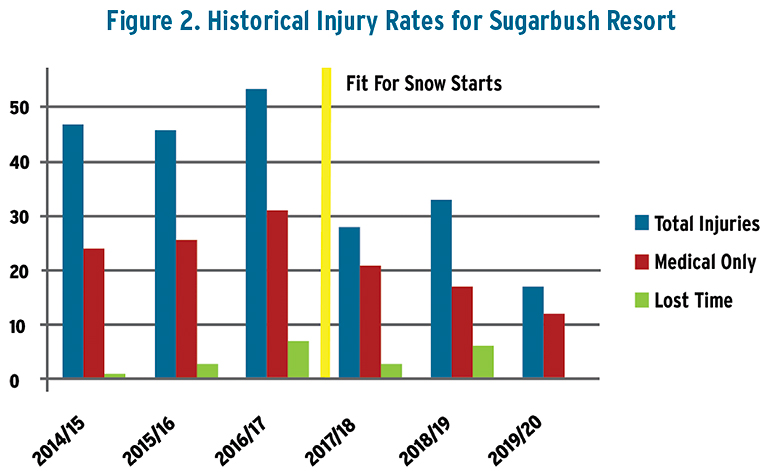
Implementation. All of the required tenets for a successful health and wellness program were in place at Sugarbush:
• Support from management at all levels: Upper management committed the financial and personnel resources to support the program, and a comprehensive plan was put in place for training at each level of management, with key focus on supporting front-line field supervisors.
• Repeat exposure: Fit for Snow has been an agenda item for management review on a weekly basis during the winter season. The resort also committed to following the program for at least four years.
• Engaged management: Front-line field supervisors and managers were engaged, backed up with incentives to use and support the program, and have been held accountable for their use of the program.
• Adequate resources: Support for the program includes paid staff, supplies, and time allotted for in-house staff training. Incentive rewards are provided, with dedicated administrative oversight.
• Constant evaluation and refinement: Employees were given a strong voice. Advocates champion the program with the encouragement of management, which has stayed committed to reinvesting in program improvements.
Nutrition. As Fit for Snow was rolled out at Sugarbush, communication and support from management enabled staff to build on the resort’s existing wellness and safety culture.
Some changes were relatively simple and low cost: distributing reusable water bottles; installing hydration stations around the resort (which benefited guests as well); and ensuring all employees resort-wide had reasonable access to drinking water. Posters encouraging hydration were designed and posted in employee work areas (Figure 3).
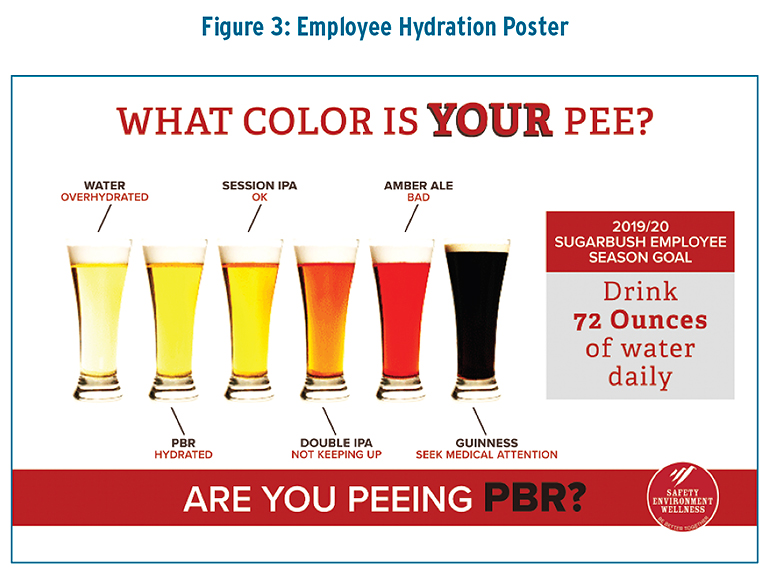
Other items—such as access to healthy, affordable food for staff—presented greater logistical challenges, and led to a tiered, season-by-season approach.
Initially, Sugarbush organized staff events that incorporated healthy food with social gatherings, such as cooking classes and group potlucks. Locker room meeting treats like chips, donuts, and pizza were replaced with healthier choices, including oatmeal, seltzer water, chocolate milk, and fruits and veggies. Healthy snacks were handed out on busy Saturdays and holiday weekends, when the staff needed stable blood sugar the most. And eventually, food and beverage began providing healthy, discounted grab-and-go items in the resort cafeterias.
Messaging. Weekly advice describing how to incorporate healthy behaviors is packaged according to the needs of the front-line field supervisors. A variety of platforms are used to deliver the messaging, depending on the location, timing, and specific cultures of the various employee groups (patrol, instructors, lift ops). The materials include:
• copies of the program manuals;
• custom pamphlets;
• locally designed posters;
• program snapshots (index cards with 2-3 sentence safety/health and wellness messages);
• incorporating on-snow movement strategies into regular training exercises;
• warm-up and locker room exercises to develop proprioceptive strategies;
• blog posts and newsletter items;
• pre-season training videos;
• staff social events that include some education or training in the program; and
• exercise facilities/fitness classes.
Support and reinforcement. Fit for Snow health and wellness tenets are regularly blended into existing performance training activities. This is critical, because a one-time pre-season exposure to the program is not sufficient to make it part of the resort culture. This is especially true early season, where time pressures, pre-season training overload, and in some cases language difficulties, increase the challenge of running effective training sessions.
Advocates lead the way. To overcome these constraints, Sugarbush invested significant time in training a small group of program advocates in the three departments—patrol, lift ops, and snowsports school. These individuals act as liaisons and program champions. They help identify the needs of the staff in each respective department and gradually have assumed an active role in incorporating the various program resources with their peers. Many of the advocates have helped shape the program, too.
Advocates are supported by field supervisors, department heads, and two content experts (the resort’s fitness trainer and the health and safety coordinator). They also receive resort recognition and some compensation. This support was critical in nurturing the advocates into a more active role in the program.
In just three years, Fit for Snow has became part of the Sugarbush culture. It has helped forge a family of employees who are truly engaged in health, wellness, and safety, on and off the mountain. This has led to impressive financial savings through a reduction in injuries and zero lost time incidents. But more importantly, the Sugarbush community sees Fit for Snow not as an imposed set of rules, but rather as a sustainable lifestyle.
It Takes Commitment
Integrating safety with health and wellness can produce excellent results, both in lower injury liability costs and a healthier, higher-performing team of staff. Enhancing health and wellness and helping employees achieve their performance goals shifts the safety culture from extrinsic policing toward positive intrinsic change.
Programs like Fit for Snow, which address the unique challenges experienced by snowsport resort employees, have proven successful. And it takes a significant commitment from leadership to achieve a successful outcome.





